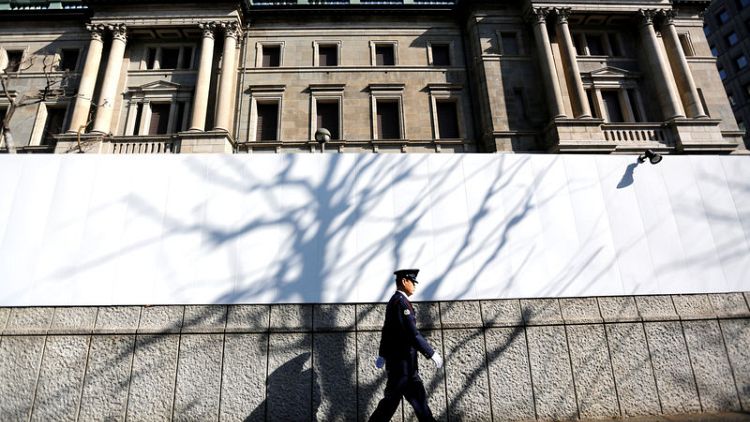By Leika Kihara and Daniel Leussink
TOKYO (Reuters) - The Bank of Japan kept monetary policy steady on Thursday as expected but offered a stronger signal it may cut interest rates in future, underscoring its concern that overseas risks could derail the country's fragile economic recovery.
The decision came hours after the U.S. Federal Reserve lowered rates again on Wednesday but signalled a pause in further cuts unless the economy took a turn for the worse.
The BOJ, which has far more limited policy ammunition, kept its short-term rate target at -0.1% and that for the 10-year government bond yield at around 0%.
It also maintained a pledge to buy government bonds so its holdings increase at an annual pace of roughly 80 trillion yen ($736 billion).
But the BOJ modified its forward guidance - a signal central banks give to markets on future policy moves - to indicate more clearly its readiness to cut rates if needed.
"The BOJ expects short- and long-term interest rates to remain at present or lower levels as long as needed to pay close attention to the possibility that the momentum toward achieving its price target will be lost," the central bank said in a statement announcing its policy decision.
That compared with the previous language that committed to keep "current ultra-low rates for an extended period of time, at least until the spring of 2020."
The vote on keeping rates steady was 7-2, while that on changing forward guidance was 8-1.
INFLATION FORECASTS CUT
In fresh quarterly projections, the BOJ also cut its inflation forecasts as falling fuel costs and soft household spending weigh on price growth.
Core consumer prices in Tokyo, a leading indicator of nationwide inflation, rose 0.5% in October from a year earlier, staying well away from the bank's 2% target.
The BOJ has recently stepped up its rhetoric on the chance of near-term easing as the global slowdown and trade tensions hurt Japan's export-reliant economy.
In July, it pledged to act pre-emptively to fend off risks that could knock the economy off the path toward achieving its inflation goal.
That was followed by a warning last month that the BOJ would use its October rate review to look more thoroughly at overseas risks, stoking market speculation of immediate action.
But analysts have said the hurdle for easing further, such as by deepening negative rates, is high given the strain ultra-low rates is already inflicting on commercial banks.
S&P Global Ratings warned on Tuesday that Japanese regional banks will see core operating profits fall by 21% if the BOJ deepens negative rates.
Also giving the BOJ more breathing room, the yen <JPY=> has shown some signs of steadying recently. Some analysts have forecast that sharp yen gains, which would further pressure exports, could prod the bank into action.
($1 = 108.6900 yen)
(Additional reporting by Tetsushi Kajimoto, Kaori Kaneko, David Dolan and Mari Saito; Editing by Jacqueline Wong and Stephen Coates)



